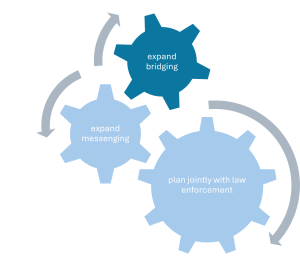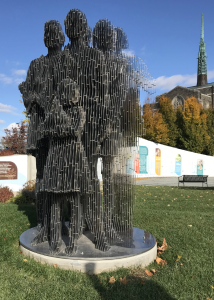6. Expand Constructive Community Practices to Prepare for Divisive Events
Many communities already focus on activities that build positive interactions across their differences and ways to address issues together in constructive and respectful ways. Expanding these activities during times of tension – locally and local implications of national and international issues — can reduce the tendency to view those with opposing views as an “enemy.” Preparation to scale up these efforts before a triggering moment can contribute to a constructive handling of these threats to community trust.
Why take this step?
 Developing (or enhancing) productive processes and relationships so that they become part of the entire community’s customary practices can be challenging. Communities stand a better chance of stemming the most damaging community unrest and lasting bitter divides if residents strengthen their trust among one another – sometimes referred to as “social capital” – during tranquil times. A carefully thought-out plan that sets up mechanisms and establishes patterns for communication and joint problem-solving can result in trusted relationships so the community can react with resilience even when facing difficult problems.
Developing (or enhancing) productive processes and relationships so that they become part of the entire community’s customary practices can be challenging. Communities stand a better chance of stemming the most damaging community unrest and lasting bitter divides if residents strengthen their trust among one another – sometimes referred to as “social capital” – during tranquil times. A carefully thought-out plan that sets up mechanisms and establishes patterns for communication and joint problem-solving can result in trusted relationships so the community can react with resilience even when facing difficult problems.
How to take this step
CHECKLIST: Ideas to Establish Constructive Patterns of Interacting About Problems
- Work to ensure that public officials are included in positive community engagement activities with community leaders, such as potlucks, cultural art and music festivals, and community celebrations.
- Support interfaith conversations aimed towards building understanding and communication across divides, such as reciprocal appearances by religious leaders at each other’s houses of worship to share how their respective religious traditions address a common theme – e.g. “hope.”
- Engage in activities that can help participants realize that their common values, e.g., fairness and belonging to a community, outnumber their differing values.
- Promote community efforts that organize and conduct educational workshops on how to conduct difficult conversations that simultaneously foster peaceful interaction.
- Work with media to develop a plan for all media (including social media), to convey accurately what is occurring to the broader community.
- Plan regular meetings of spokespersons from different organizations to share matters of concern to their interest groups with public officials and with each other.
- Encourage all leaders who make public statements to refer to the community’s shared goals (see Chapter 3) — and its customary practices of resolving differences – in “sound-bites” or other appropriate phrases i.e., its distinctive identity and values (e.g. “we are meeting tonight to hear your concerns because we are committed in [city] to making decisions through dialogue and engagement, not acts of destruction.”).
ILLUSTRATION | Charleston, SC
Finding ways to connect across differences, focus on shared values
Rabbi Victor Urecki of Charleston, South Carolina, talks about strategies that at first did not work and later, after a course correction, created cordial relationships among Jews, Christians, and Muslims in that community. The religious leaders got together many years ago with the idea of talking about the issues most important to each of them. Some leaders wanted to talk about abortion, some about social action, and others about anti-Semitism. Each was talking about a distinctive issue that was important to him/ her. There was a collective recognition that the religious leaders were talking at each other, not with each other, and the relationships broke down. The group refocused, but rather than talking about “hot button” issues, they all began the relationship in a simpler way: talking about the activities that constituted their workdays or what matters were going on in their congregations. One religious leader, for example, shared the following: “I have a congregant going through a difficult divorce; here’s what I’m doing. Have any of you had this experience? What did you do?” These conversations created positive relationships, since the conversations enabled different religious leaders to support one other. Conducting the more difficult conversations about “hot button” issues, if they arise, are now more constructive, they have talked as friends first, then as colleagues.
ILLUSTRATION | Columbus, OH

Finding ways to connect across differences, focus on shared values
The Greater Columbus Arts Council commissioned a sculpture to focus on the shared values of fairness and unity, specifically to represent the quote, “Injustice anywhere is a threat to justice everywhere. We are caught in an inescapable network of mutuality, tied in a single garment of destiny. Whatever affects one directly affects all indirectly.”[1] The resulting sculpture, “Our Single Garment of Destiny,” created by Julian and Adriana Voss-Andreae in 2021, is visible from a major downtown street.
The Arts Council added this sculpture to enhance shared values and unity among Columbus residents.
- Rev. Martin Luther King, Jr., Letter from Birmingham Jail (1963). ↵
